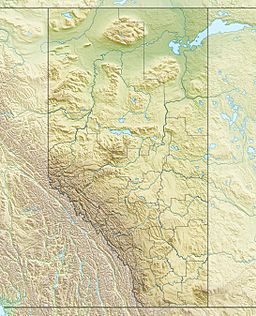Moore Lake (Alberta) facts for kids
Quick facts for kids Moore Lake |
|
|---|---|
| Location | Bonnyville No. 87, Alberta |
| Coordinates | 54°31′N 110°31′W / 54.517°N 110.517°W |
| Basin countries | Canada |
| Max. length | 3.5 km (2.2 mi) |
| Max. width | 6 km (3.7 mi) |
| Surface area | 9.28 km2 (3.58 sq mi) |
| Average depth | 8.3 m (27 ft) |
| Max. depth | 26 m (85 ft) |
| Surface elevation | 548 m (1,798 ft) |
Moore Lake is a beautiful lake located in Alberta, Canada. It is a popular spot for outdoor activities and a home for many plants and animals. This lake is found in the Municipal District of Bonnyville No. 87, which is in the eastern part of Alberta.
Contents
About Moore Lake
Moore Lake is a medium-sized lake. It is about 3.5 kilometers (2.2 miles) long. The lake is also about 6 kilometers (3.7 miles) wide. Its total area covers around 9.28 square kilometers (3.58 square miles).
Location and Size
The lake sits at an elevation of 548 meters (1,798 feet) above sea level. It has an average depth of 8.3 meters (27 feet). However, in some spots, the lake can be as deep as 26 meters (85 feet). This makes it a fairly deep lake in certain areas.
What Can You Do There?
Moore Lake is a great place for many fun activities. During the warmer months, people enjoy boating and fishing. The lake is known to have different types of fish. In winter, when the lake freezes over, ice fishing becomes popular. Some visitors also enjoy camping near the lake. It is a peaceful spot to connect with nature.
Plants and Animals
Lakes like Moore Lake are important ecosystems. They provide a home for many different plants and animals. In the water, you might find various fish species. These can include pike, perch, and walleye. Different kinds of aquatic plants also grow in the lake.
Around the lake, you can often see many types of birds. Ducks, geese, and other waterfowl are common. Sometimes, you might even spot larger animals like deer or moose near the shore. These animals come to the lake for water and food. The lake's environment supports a rich variety of wildlife.
How Lakes Are Formed
Most lakes in Alberta, including Moore Lake, were formed a long time ago. This happened during the last Ice age. Huge sheets of ice, called glaciers, moved across the land. As they moved, these glaciers carved out hollows and valleys. When the glaciers melted, these hollows filled with water. This process created many of the lakes we see today.


